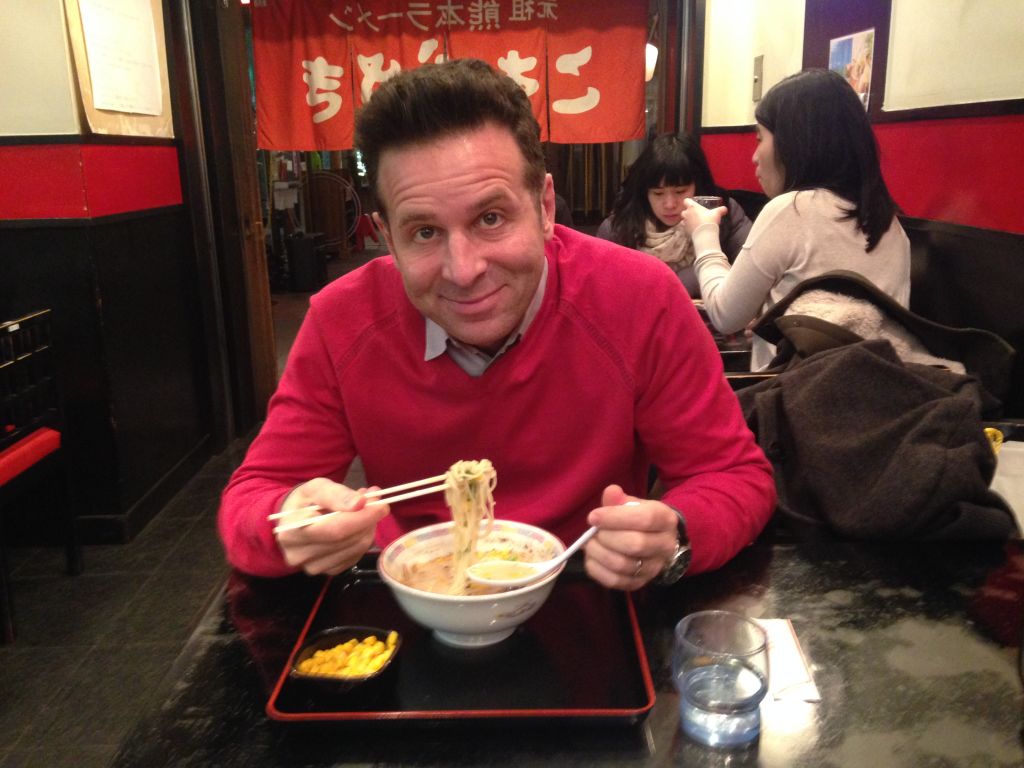
Ramen Museum An Umami Fest
Enjoying my second bowl of the afternoon at the Ramen Museum.
Yokohama, Japan – I was expecting a “Noodle Hall of Fame” or a “Best of the Broths” lineage. I had no idea the Ramen Museum in Shinyokohama (the “new” part of Yokohama) about 30 miles from central Tokyo, would actually serve the stuff. I was planning on visiting both of Japan’s ramen museums for a story – there’s another one in Osaka, which centers on the origins of the instant stuff we had in college – but this behemoth of a building on a fashionable side street in town showed no indication that there would be anything to eat, other than a few souvenirs.

Admission is about $3 for adults, a buck for kids. As you enter, you’re met with a wall of Ramen all-stars, each renown for his (they’re all dudes) style of ramen. They tend to hew to regional tastes, but in general, the only differences are the broths and noodles.

Just past this preview wall is the expected souvenir shop. Naturally, there are trinkets and tchochkes like key chains and erasers, but there are also ramen kits, designed and packaged by each of the ramen shops in the building, allowing fans to take the ramen home, so to speak, where you can test out their broth and noodles, then add whatever condiments you like, such as pickled bamboo, cooked pork and fish cakes (all shrink-wrapped and sold separately for easy use).

At this point I’m thinking, ‘nice, it’s basically a store to buy ramen paraphernalia – bowls, strainers, stock pots – pretty much anything you would need to make ramen at home. Then you descend a staircase, and wind up in a set piece from a 1960s Japanese detective film. Whoever they hired as a set designer, did a magnificent job of transporting you to another era, long before “Iron Chef” and “No Reservations.”

Abandoned motor scooters and unoccupied police stations make it seem like the town evacuated before Godzilla arrived. Wall calendars from 1958 are hung on distressed walls; antennas are askew over ancient apartments buildings, and tucked in among the tiny hotels and public washroom signs are at least nine serious ramen shops.

The first stop was at Sumire, one of Japan’s most famous ramen shops. Like every ramen joint in Japan, you first encounter a vending machine out front, and decide the size of your bowl (I’d recommend getting half sizes if you’re going to sample) then decide if you want bamboo, fish cake or egg. In some cases, there are no choices for condiments; you simply get it the way it’s supposed to be served. In the case of Sumire, the soup broth is a thick, miso base, with a top layer of fat and oil that literally coats your tongue and stomach. Hokkaido-style noodles (my favorite) are curly and toothsome, medium thick. Garnish is limited to some crumbled pork, scallions and a few shards of bamboo. Delicious, but really heavy.

The next stop, Komurasaki, has been making ramen since 1954. This base is a milky-white tonkotsu (pork bone broth) but they also add chicken bones and vegetables to mellow it out, making it more than one-dimensional. I thought the noodles were weak, however, more like angel hair pasta and far too delicate, but the addition of roasted and crumbled garlic chips over the top was a nice touch, and I opted to get a side of corn for color and flavor:

Finally, our third stop brought us to Kamome Shokudo, on the basement floor of the two-story “ramen town.” This famous shop was swept away in the 2011 earthquake and tsunami, and proceeds from sales here go to help restore the area. The clearer broth is a mixture of chicken and seafood (shoyu) with salt being omnipresent but not too much so. I love this broth. It’s rich and dark, but not heavy and cloying. It’s been skimmed, but not to the point of removing all of those little fat globules resting on the surface. Garnishes here are stellar: naruto (fish cake), a split-open boiled egg with that trademark orange yolk, some kelp, a few stalks of pickled bamboo and a piece of dried nori for extra umami, as well as two large pieces of chasu roasted pork, simultaneously fatty and lean. The noodles are curly, but not quite as hard and chewy as the first bowl. Now, if I could just figure out a way to combine the noodles from Hokkaido with the shoyu broth from the North coast, plus the egg and pork, I’d be onto something.

Ramen Museum
2-14-21 Shinyokohama, Kohoku-ku
Yokohama City, 222-0033
+81-45-471-0503
